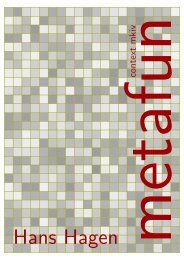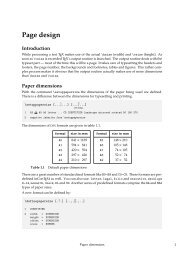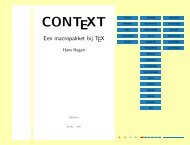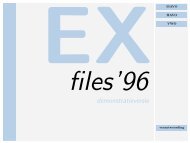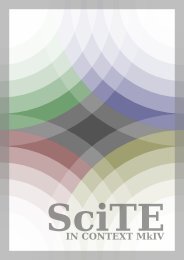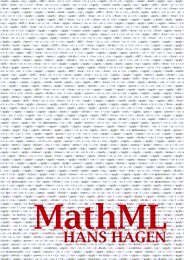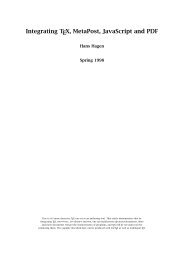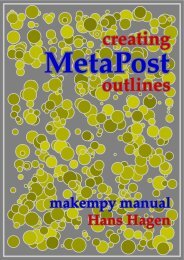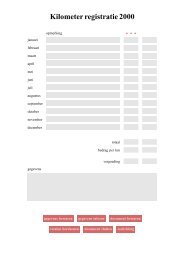Hagen - Pragma ADE
Hagen - Pragma ADE
Hagen - Pragma ADE
Create successful ePaper yourself
Turn your PDF publications into a flip-book with our unique Google optimized e-Paper software.
anyway. It’s interesting to notice that some of the encodings contain symbols that are<br />
never used or used only once in a document, like the copyright or registered symbols.<br />
They are often accessed by symbolic names and therefore easily could have been omitted<br />
and collected in a dedicated symbol font thereby freeing slots for more useful characters<br />
anyway. The lack of coverage is probably one of the reasons why new encodings kept<br />
popping up. In the next table you see how many files are involved in Latin Modern which<br />
comes in a couple of design sizes. 2<br />
font format type # files size in bytes ConT E Xt<br />
type 1 tfm 380 3.841.708<br />
afm 25 2.697.583<br />
pfb 92 9.193.082<br />
enc 15 37.605<br />
map 9 42.040<br />
521 15.812.018 mkii<br />
opentype otf 73 8.224.100 mkiv<br />
A tfm file can contain so called italic corrections. This is an additional kern that can<br />
be added after a character in order to get better spacing between an italic shape and<br />
an upright one. As this is manual work, it’s a not that advanced mechanism, but in<br />
addition to width, height, depth, kerns and ligatures it is nevertheless a useful piece of<br />
information. But, it’s a rather T E X specific quantity.<br />
Since T E X showed up many fonts have been added. In addition support for commercial<br />
fonts was provided. In fact, for that to happen, one only needs accompanying metric<br />
files for T E X itself and map files and encoding vectors for the backend. Because a metric<br />
file also has some general information, like spacing (including stretch and shrink), the<br />
ex-height and em-width, this means that sometimes guesses must be made when the<br />
original font does not come with such parameters.<br />
At some point virtual fonts were introduced. In a virtual font a tfm file has an accompanying<br />
vf file. In that file each glyph has a specification that tells where to find the<br />
real glyph. It is even possible to construct glyphs from other glyphs. In traditional T E X<br />
this only concerns the backend, which in pdfT E X is built in. In LuaT E X this mechanism<br />
is integrated into the frontend which means that users can construct such virtual fonts<br />
themselves. We will see more of that later, but for now it’s enough to know that when<br />
we talk about the representation of font (the tfm table) in LuaT E X, this includes virtual<br />
functionality.<br />
An important limitation of tfm files cq. traditional T E X is that the number of depths and<br />
heights is limited to 16 each. Although this results in somewhat inaccurate dimensions<br />
in practice this gets unnoticed, if only because many designs have some consistency in<br />
this. On the other hand, it is a limitation when we start thinking of accents or even<br />
2 The original Computer Modern fonts have METAFONT source files and (runtime) generated bitmap files in whatever<br />
resolutions are needed for previewing and printing. The Type1 follow-up came in several sets, organized by<br />
language support. The Latin Modern fonts have a few more weights and variants than Computer Modern.<br />
11<br />
Font formats



